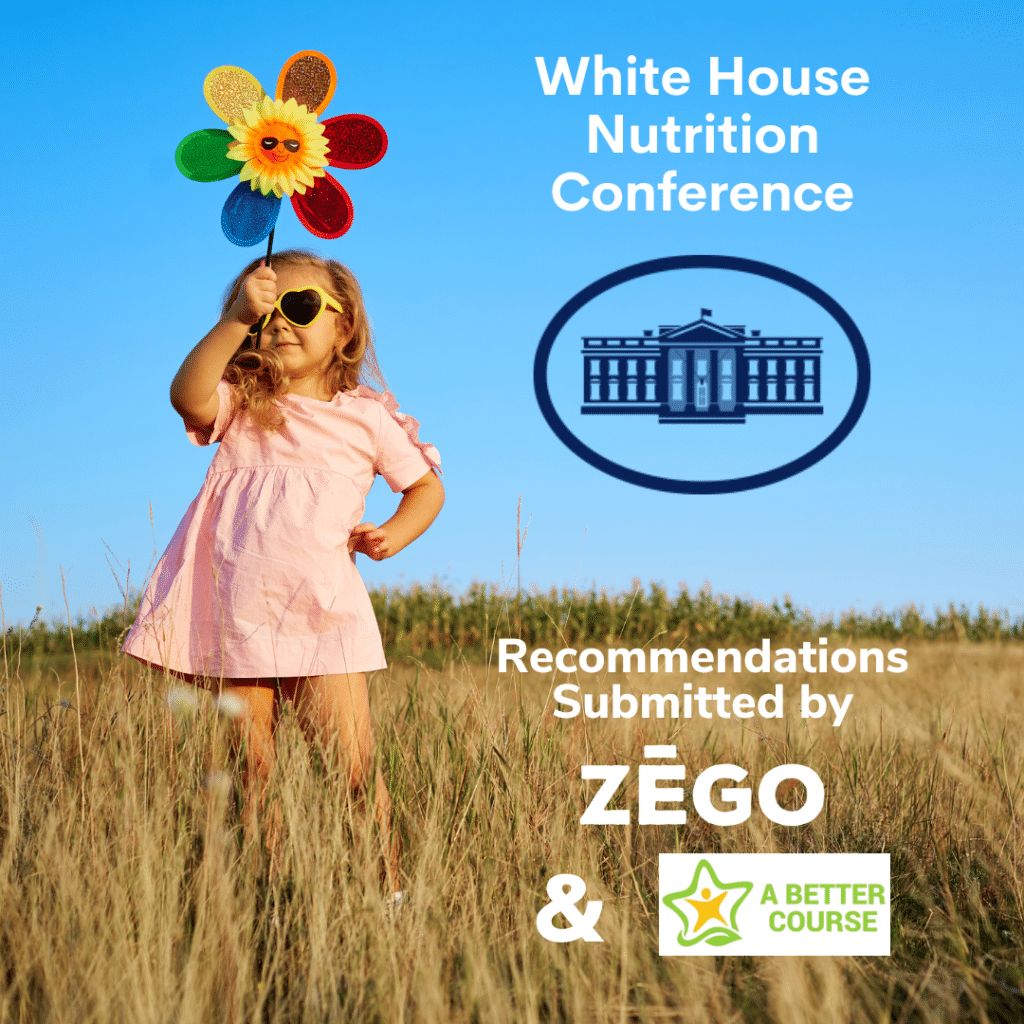Last Updated on June 11, 2024 by Website Support

In September 2022, the White House is holding a meeting to discuss the future of federal nutrition programs. This is a unique opportunity to refocus these programs to bring about healthier people and planet.
Most of us are familiar with at least a couple of federal nutrition programs like the National School Lunch and Breakfast Programs, Women, Infants, and Children’s (WIC) Program, Food Stamps (SNAP), Child and Adult Care Food Program to name a few. Even more on point, nearly half of Americans have benefitted from Food Stamp (SNAP) food assistance at some point in their lives.

ZEGO and A Better Course are dedicated to improving nutrition for people experiencing food insecurity in our country.
ZEGO, as a for-profit company, and A Better Course, as a nonprofit project, believe legislators need to broaden the focus of these programs from simply access, calories, and macronutrients to include the nutrition density of the food and the toxic residues it carries from chemicals and toxins introduced in the growing, storing, and processing of the food.
Below is our submission of our ideas to the White House Nutrition Conference from July 29, 2022. We would love to hear your feedback in the comments or at community@zegofoods.com! The more we learn, the better we get. We are better together.

SUMMARY: Our Submission to White House Nutrition Conference
Federal nutrition programs unwittingly contribute to increased chronic disease in low-income households and communities by passing along the nutrition deficits and toxicity in our food system. To correct this and better support health, the traditional focus of the programs (access, calories, food components/choices, and macronutrients) must be expanded to address:
· Increasing food quality (natural nutrition density of the food) and
· Increasing food purity (absence from chemicals and heavy metals).
The traditional focus of the federal anti-hunger nutrition programs for the past 50 years has been to improve the health of lower-income people in our country by providing them access to adequate quantities of food. Many dedicated people – from administrators to anti-hunger advocates to Congress have made tremendous progress on this goal.
But times have changed. And though these calorie and access goals were adequate 50 years ago, they are not anymore.
The growth of chemical-based farming has depleted soil health and nutrient density in the food grown in it. And, we know dangerous concentrations of heavy metals have been measured in food products like baby food and juice due to careless processing practices, historic industrial contamination, and deliberate use in agriculture.
Dedicated school lunch line workers, childcare providers, and WIC administrators take great care in the food they provide through the federal anti-hunger programs is designed to prevent disease and promote health. They know these programs are supposed to increase the recipient’s chance at living a better life, being self-sufficient and self-determinant.
But the programs cannot be better than the food system on which they rely. Tragically, they now serve nutrient-depleted food containing unmonitored toxic chemical residue to children, babies, mothers, and food insecure households.
Background
For more background, we offer these references. The first two are from the submission by the American Sustainable Business Network (ASBN), which was submitted to the White House Nutrition Conference in July 2022.
- Growing bodies of research show that foods grown in nutrient-deficient soil lack important micronutrients required for health and development in children (https://bionutrient.org).
- An assessment of the nutritional concentrations of 43 crops, mostly fruits, and vegetables, from 1950 to 1999 revealed a decline in most nutrients. In some cases nutrition loss is up to 50% in grains like wheat, rice, and barley (see Rodale Institute’s The Power of the Plate, pg. 16).
- Even though “chemical contaminants are severely under researched,” it is clear some manufactured chemicals (e.g., pesticides and plastics) and natural chemicals (e.g., mycotoxins and lead) in food harm human health (from NIH paper, Research on health impacts of chemical contaminants in food, Abstract, for examples, also see World Health Organization estimates of the global and regional disease burden of four foodborne chemical toxins, 2010: a data synthesis.
This is contributing to the chronic diseases and health concerns that plague our country and in particular lower-income people and communities.
The problems that must be addressed now are
- increasing food quality by improving the natural nutrient density of the food in these programs, and
- increasing food purity by lowering the toxic residue the food carries from the farm and processing plant to the child, mother, and others in need.
And, because the federal nutrition programs purchase so much volume of food each year, reducing harmful chemicals in that food system will help increase nationwide soil health. In turn, this will help restore nutrition across the board density to historic levels.
Recommendations
To begin the work on these two critical issues, we recommend the following.
1. Establish a baseline. Measure the amount of chemical residue (e.g., pesticides, heavy metals, plastics) federal food assistance programs pass on to their customers (children, mothers, infants, and adults).
2. Develop a comprehensive cost/benefit formula. This could be similar to the WIC analysis used for years but updated to include toxic exposure from food and calculated for all the federal nutrition programs.
a. Determine how much money Medicaid, the health care industry, and the economy as a whole would save if the toxic residue in these food programs were decreased and the nutrient density increased to the levels measured before the adoption of widespread chemical farming.
i. Account for the combined health effect of the total exposure of all the residue passed to individuals through these programs.
ii. Estimate the health care savings that would be realized in terms of chronic disease and other health issues linked to chronic diseases, like increased chance of severe Covid and resulting hospitalization.
Iii. Estimate the value of decreasing toxic residue in food and increasing nutrition density in terms of other health care costs, lost wages, sick time off work, lost productivity, etc.
3. Using the baseline measurement, commit to measuring and reducing chemical residue in federal food assistance programs annually.
a. Once we have a baseline measurement for current levels of toxicity, commit to decreasing those levels in federal nutrition programs through legislation, regulation, and working with industry, like what the FDA has done with its Closer to Zero program for heavy metals in baby food and fruit juice.
4. Use the biggest levers for reducing pesticide exposure first. Act immediately to bring maximum benefit to program recipients by
a. not allowing federal funds to be used to purchase crops or finished food products that have been treated with chemicals late or post-harvest for desiccation or other purposes. This would bring down program recipients’ exposure to some toxic herbicides by as much as 80% and have immediate health benefits, and
b. eliminating fruit juice from all federal nutrition assistance programs, including school meals, CACFP, SNAP, WIC, and others. This would immediately decrease the exposure of children and adults to lead and other heavy metals.
5. Review unnecessarily restrictive rules for the federal nutrition programs that keep small and regenerative producers out and support monopolistic structures that funnel food into the programs.
a. For example, eliminate restrictive parameters for sizes of produce sold to the NSLP and SBP, and
b. revise the commodity processing system that supports the NSLP and SBP to both bring in small ranchers and allow food service directors to request healthier, less processed meat products for their students.
6. Continue working to decrease administrative costs for the federal nutrition programs and use those freed-up funds to increase the quality of the food in the program so the program’s clients can purchase healthier and regeneratively grown food.
7. Use a systems-change mindset. It is tempting to make utopian pilot projects as examples of flagship programs. But pilot projects do not fix the underlying farming, processing, and regulatory systems that prevent expanding those pilots nationwide. Worst yet, they can be a detrimental distraction from the challenging work of fixing the system. Any policy and pilot project options need to be evaluated for their ability to scale rapidly and their value in benefiting ALL program recipients through system change. Increasing nutrition density and food purity 20% will do far more for the collective health of our neediest program participants in the near term than having 100% organic school lunch or childcare programs that take years to establish.
Written by Colleen Kavanagh, Founder of A Better Course and ZEGO LLC, July 29, 2022.

